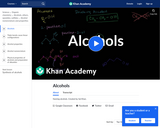
This 7-minute video lesson looks at naming alcohols. [Organic Chemistry playlist: Lesson 45 of 73].
- Subject:
- Chemistry
- Physical Science
- Material Type:
- Lecture
- Unit of Study
- Author:
- Khan, Salman
- Date Added:
- 02/20/2011
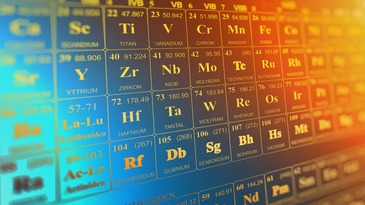

This 7-minute video lesson looks at naming alcohols. [Organic Chemistry playlist: Lesson 45 of 73].

This resource was contributed by Gamini Gunawardena, Associate Professor (Chemistry) at Utah Valley University. The materials provided with different topics will be highly useful for for undergraduate students.

The organic chemistry course is organized as three modules: I. Molecular Architecture II. Molecular Transformations: Introduction to Organic Synthesis and Reaction Mechanisms III. Chemistry of

This is the first course taken in a two sequence Organic Chemistry Course for science majors.
This course examines the behavior of hydrocarbons and their derivatives. Topics covered include alkanes, halides, alcohols, alkynes and stereochemistry.
Upon completion of this course the student will be able to perform the following: (1) Name organic compounds using both the IUPAC and Common System, (2) Determine the Stereochemistry of a compound, (3) Predict the products that will be formed from specific reactions, (4) Predict how changes in the structure of a compound can influence physical properties and reactivity, and (5) Understand the Importance of Mechanisms.
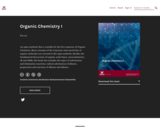
An open textbook that is suitable for the first semester of Organic Chemistry. Basic concepts of the structures and reactivities of organic molecules are covered in this open textbook. Besides the fundamental discussions of organic acids-bases, stereochemistry, IR and NMR, this book also includes the topics of substitution and elimination reactions, radical substitution of alkanes, preparation and reactions of alkenes and alkynes.

This course is designed for students majoring in a STEM area. It is the second sequence organic chemistry course.
This course examines the behavior of hydrocarbons and their derivatives. Topics covered include alcohols, alkynes, aldehydes, ketones, carboxylic acids, carboxylic acid derivatives, amines, and aromatic compounds.
Upon completion of this course the student will be able to perform the following: (1) Name organic compounds using both the IUPAC and Common System, (2) Determine the Stereochemistry of a compound, (3) Predict the major and minor products that will be formed from specific reactions, (4) Predict how modifications in chemical structure, including stereochemistry, can drastically change the physical and/or chemical behavior of compounds, and (5) Provide the mechanism for specific types of reactions.

This 7-minute video lesson provides an introduction to chirality. [Organic Chemistry playlist: Lesson 19 of 73].
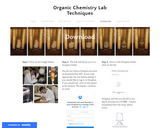
This resource was created by Lisa Nichols (chemistry faculty at Butte Community College in Northern California) as a result of an academic sabbatical leave in the Fall-2015 to Spring 2016 term. The target audience are undergraduate students in organic chemistry.
In this resource you will find theory and procedures on the main organic lab techniques (chromatography, crystallization, extraction, distillation) as well as general concepts on how to set up and heat apparatuses (see the Table of Contents tab for a more complete listing of topics).
All procedures are accompanied by step-by-step pictures, and graphics are heavily utilized throughout the resource.
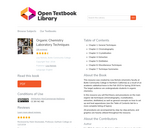
This resource was created by Lisa Nichols (chemistry faculty at Butte Community College in Northern California) as a result of an academic sabbatical leave in the Fall-2015 to Spring 2016 term. The target audience are undergraduate students in organic chemistry.
In this resource you will find theory and procedures on the main organic lab techniques (chromatography, crystallization, extraction, distillation) as well as general concepts on how to set up and heat apparatuses (see the Table of Contents tab for a more complete listing of topics).
All procedures are accompanied by step-by-step pictures, and graphics are heavily utilized throughout the resource.

Practice questions and exercises for the following: Unbranched Alkanes, Constitutional Isomers, Alkyl Substituents, Alkenes and Alkynes, Halogens, Benzene and Conjugation, Alcohols, Ethers, Aldehydes and Ketones, Carboxylic acids and Esters, Amines and Amides
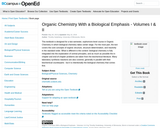
A free, open-access organic chemistry textbook (volumes I and II) in which the main focus is on relevance to biology and medicine. This is a PDF version of a wiki project called Chemwiki at the University of California, Davis. There are also supplementary materials, such as PowerPoint slides and a solutions manual available for this textbook at the Chemwiki website.

The content of this reading resource was selected to support you in meeting the module reading outcomes. Please note that this reading resource alone may not fulfill all of the listed module reading outcomes and that additional individual research may be necessary to fully prepare for class. The majority of the content was adapted from Anatomy and Physiology by Rice University (licensed under a Creative Commons Attribution 4.0 International License.)

Physical Chemistry is the application of physical principles and measurements to understand the properties of matter, as well as for the development of new technologies for the environment, energy and medicine. Advanced Physical Chemistry topics include different spectroscopic methods (Raman, ultrafast and mass spectroscopy, nuclear magnetic and electron paramagnetic resonance, x-ray absorption and atomic force microscopy) as well as theoretical and computational tools to provide atomic-level understanding for applications such as: nanodevices for bio-detection and receptors, interfacial chemistry of catalysis and implants, electron and proton transfer, protein function, photosynthesis and airborne particles in the atmosphere.
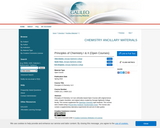
Principles of Chemistry I & II are LibGuides-based Open Courses with original lecture notes, chapter checklists, and original videos created by Georgia Highlands College faculty. The courses supplement the OpenStax Chemistry open textbook. The courses were created using a Round Nine Textbook Transformation Grant. The courses also contain a supplementary laboratory experiments list and set of video guides.

This course is an intensive survey of general, organic, and biological chemistry specifically designed for nursing majors and other health related fields. Topics include general chemistry, organic chemistry, and biological chemistry as applied to the chemistry of the human body.

This guidebook was created by ISKME, in partnership with the Science Education Resource Center (SERC) at Carleton College. The document provides a practical reference for curators and authors of STEM OER, and contains 23 accessibility criteria, or elements, to reference as they curate, design and adapt materials to be accessible for STEM learners.
The primary audience of this resource is STEM postsecondary faculty, instructional designers, and others responsible for course design and pedagogy who seek to:
- Expand their knowledge about accessibility and ways to integrate it into their STEM curriculum and instruction
- Design openly licensed STEM courses and course materials that support both access and use by learners
- Curate existing STEM content that expands upon traditional textbooks and courseware to address variability in learning
- Identify and add meaningful keywords, or tags, to the STEM OER they create, so that their OER can be more easily discovered across platforms
Professional learning teams on campus are also encouraged to use this framework as part of training to facilitate integration of accessibility concepts into STEM course design and pedagogy.
The framework and guide development was supported by a mini-grant program facilitated by Bates College and the SCORE-UBE Network (Sustainability Challenges for Open Resources to promote an Equitable Undergraduate Biology Education), with funding from The William and Flora Hewlett Foundation. The framework and guide were developed by ISKME and SERC with input from 21 STEM faculty members from across the United States, and in collaboration with the project’s Working Group of accessibility experts: Andrew Hasley and Hayley Orndorf, both with BioQUEST’s UDL Initiative and the Quantitative Undergraduate Biology Education and Synthesis (QUBES) Project; Hannah Davidson, Plymouth State University; and Cynthia Curry, National Center on Accessible Educational Materials (AEM)/CAST.

This exercise is a laboratory activity designed for a CHM101 course. This activity has students take various lengths and volumes to practice recording measurements with correct significant figures. Students will also use some measurements in calculations and practice rounding calculated values to the correct number of significant figures.
![Thermochemistry: Heat of Neutralization and Hess's Law [Chemistry]](https://vivaopen.oercommons.org/static/newdesign/images/materials/default-thumbnail-index.png)
The General Chemistry 1 (SCC 201) course has been designated for the core competency of Inquiry and Problem Solving along with the Written Communication Ability. These abilities are best observed in the laboratory section of the course where SCC 201 students are asked to submit weekly written lab reports that range in chemistry topics from chemical structures to the chemical analysis of polluted environments. SCC 201 will be implementing a new experiment in the laboratory portion of the course entitled, "Thermochemistry: Heat of Neutralization and Hess's Law. The design of the experiment incorporates many elements of LaGCC's Core Competencies and Communication Abilities, as well as programmatic and course learning objectives both on the departmental and college levels. Natural Sciences major STEM students who successfully complete the thermochemistry lab and write a corresponding satisfactory lab report, will have engaged in two of the program goals, four of the student learning objectives and seven of the course objectives (Please refer to the assignment). The SCC 201 course lies in the midpoint Core Competency program curriculum map for both the Biology and Environmental Science programs and accounts for 3.5% of the final SCC 201 grade. Students will spend 3 hours completing the experiment in lab and in addition spend an estimated 3-4 hours completing the lab write-up. This lab was developed in the Natural Sciences programmatic integration CTL mini-grant seminar. The creation of the lab involved an initial discussion with members of the chemistry programmatic team to outline a common theme between SCC 201, SCC 202 and SCC 251. It was agreed upon that the central topic of thermodynamics would be implemented throughout the designated labs.
LaGuardia's Core Competencies and Communication Abilities
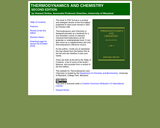
Thermodynamics and Chemistry is designed primarily as a textbook for a one-semester course in classical chemical thermodynamics at the graduate or undergraduate level. It can also serve as a supplementary text and thermodynamics reference source.
![Titration of a Newtown Creek Environmental Water Sample to Determine the Amount of Chloride Ions [Chemistry]](https://vivaopen.oercommons.org/static/newdesign/images/materials/default-thumbnail-index.png)
Main Course Learning Objectives:
The General Chemistry 1 (SCC 201) course has multiple course learning objectives, which articulate key introductory chemistry concepts that all STEM students should possess. In particular, the Newtown Creek titration experiment aligns with SCC 201 learning objectives of: Demonstrate an appreciation of the role of chemistry in various aspects of life Perform basic laboratory skills such as the proper execution of titration techniques Describe and explain the fundamental chemistry concept of solution concentration Analyze and represent experimental data in tables and graphs, interpret experimental results and write laboratory reports
In the SCC 201 laboratory, students are asked to complete the experiment and then use the data to write a formal written lab report, which consists of an introduction, materials, methods, results, discussion and conclusion. The student work serves as an excellent artifact under the Written Communication Ability, which is designated for the SCC 201 course. In addition, the Global Learning Core Competency is incorporated in the Newtown Creek titration experiment, where students are asked to measure the chloride concentrations from the Superfund site. After calculating and determining the chloride amounts, students are prompted to discuss the impact of the findings on the Newtown Creek site and furthermore the surrounding environment on both a microscopic and macroscopic level. For example, students are asked to compare the chloride concentration values to the standards set forth by the Environmental Protection Agency and to address the implications of the pollutant on existing plant life and people who reside near Newtown Creek. The responses from students show the success in meeting the dimensions of the Global Learning Core Competency. The SCC 201 course lies in the midpoint of the program curriculum map for both the Biology and Environmental Science programs and this laboratory assignment accounts for 3.5% of the final SCC 201 grade. LaGCC STEM major students will spend 3 hours completing the experiment in lab and as well spend an estimated 3-4 hours completing the lab write-up. The Titration of a Newtown Creek Environmental Water Sample to Determine the Amount of Chloride Ions experiment was developed as part of the Community College Undergraduate Research Initiative (CCURI). Additionally, this work was workshopped in an assignment development charrette during the 2018-2019 CTL Mini-Grant Global Learning Sub-seminar.
LaGuardia‰Ûªs Core Competencies and Communication Abilities